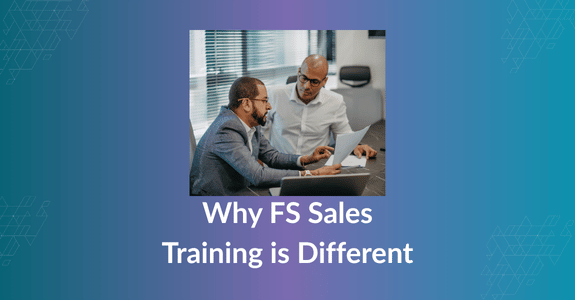Why Financial Services Sales Training is Different
by Mentor Group

Why FS selling demands a different playbook
Financial services selling combines complex regulation, suitability requirements, and product complexity. That mix changes how sellers discover needs, position value and close. The priority isn’t a slick pitch—it’s a safe, evidence‑based advisory conversation that builds trust and stands up to audit.
For context, UK firms operate under conduct and promotions rules that shape how sellers engage and what evidence they must retain. FCA COBS
And data privacy obligations govern how information is collected and used in discovery and follow‑up.UK GDPR guidance (ICO)
What to teach first (and why)
Focus on five capabilities that change outcomes quickly while lowering risk:
- Regulatory confidence by design: sellers know when and how to make disclosures, seek consent, and document suitability.
- Problem‑led product fluency: translate lending, treasury, wealth and insurance features into outcomes and risk trade‑offs for specific customer contexts.
- Modern discovery: go beyond needs to include goals, risks, constraints and decision dynamics—captured in CRM notes that satisfy compliance.
- Digital + human selling: align to buyers who research online and engage selectively with experts; teach when a human moment meaningfully advances trust.
- Manager‑led reinforcement: a weekly cadence for pipeline hygiene, deal quality and skill coaching turns learning into behaviour.
Buyer behaviour supports this emphasis on discovery and guidance over persuasion; sellers join late and must add value fast.Gartner’s B2B buying research
Make compliance a feature of the conversation
Treat compliance as part of the value proposition rather than a separate hurdle. Build exercises that make disclosures, privacy choices and suitability second nature. Capture artefacts—notes, checklists, attestations—that reduce audit time.
Regulators expect firms to demonstrate effective control across fast‑moving areas like AI use, outsourcing and cyber, so training needs to ‘shift‑left’ into daily workflows.KPMG on transforming FS compliance
Role‑specific learning paths that scale
Training should reflect different realities across the bank or insurer: relationship managers, product specialists and contact‑centre teams have distinct moments of truth. Keep content short and contextual, then reinforce with practice and manager coaching.
Measurement signals in weeks, not months
Prove progress quickly with leading indicators before full financial outcomes appear:
- Diagnostic depth: completeness of documented needs, risks and constraints in CRM.
- Proposal quality: clarity, suitability rationale and value articulation.
- Cycle time and stage conversion: fewer stalls and cleaner exits on unqualified deals.
- Coaching cadence: proportion of reps receiving weekly deal/practice coaching.
Link training engagement and practice to revenue and risk indicators in one view; platforms that connect content, readiness and deal data make this visible.Forrester on revenue enablement signals
A pragmatic first 90 days
Weeks 1–2: diagnose capability and pipeline health; pick two behaviours per segment.
Weeks 3–6: deliver short expert‑led modules plus digital practice; managers run weekly cadence.
Weeks 7–12: deepen practice on objections, suitability and proposals; review leading indicators fortnightly; scale what works.
Bottom Line: quick answers to common questions
Q: What makes sales training different in financial services?
A: Regulation, suitability and complex products. Training unites advisory skills with risk discipline and evidence capture.
Q: What should we teach first?
A: Regulatory confidence, problem‑led product fluency, modern discovery, hybrid selling, and manager‑led reinforcement.
Q: How do we embed compliance without slowing sales?
A: Design disclosures, consent and suitability as part of the conversation; capture artefacts once, reuse across audit needs.
Q: How soon can we show impact?
A: Within 30–60 days via diagnostic depth, proposal quality, cycle time and stage conversion, then tie to cross‑sell and balance/AUM growth.
Related reading: Sales training programmes for financial services teams
